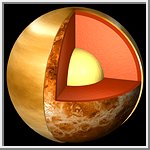|
COMETS EARTH JUPITER KUIPER BELT MARS MERCURY METEORITES NEPTUNE OORT CLOUD PLUTO SATURN SOLAR SYSTEM SPACE SUN URANUS VENUS ORDER PRINTS
PHOTO CATEGORIES SCIENCEVIEWS AMERICAN INDIAN AMPHIBIANS BIRDS BUGS FINE ART FOSSILS THE ISLANDS HISTORICAL PHOTOS MAMMALS OTHER PARKS PLANTS RELIGIOUS REPTILES SCIENCEVIEWS PRINTS
|
Related Document
Download Options
This picture shows a cutaway view of the possible internal structure of Venus. The image was created from Mariner 10 images used for the outer atmospheric layer. The surface was taken from Magellan radar images. The interior characteristics of Venus are inferred from gravity field and magnetic field measurements by Magellan and prior spacecraft. The crust is shown as adark red, the mantle as a lighter orange-red, and the core yellow. What is known about the Venusian interior comes primarily from the Venera, Pioneer Venus and Magellan spacecraft. Before these explorers, scientists thought that Venus would have tectonic processes similar to that of Earth's mantle convection. Venus and Earth are both similar in size and presumable the same composition. However, Venus showed no sign of plate tectonism, and appears to have a single plate which makes it very different from Earth. The composition of the Venusian plains was measured by several Soviet landers. These measurements indicate that they are composed of Basalts and is consistent with the morphologies shown in images taken by the Magellan spacecraft. It is also possible that the surface may be more silica-rich than on Earth as indicated by the Venera 8 spacecraft. These observations suggest that Venus is differentiated with a basaltic crust extracted from the mantle. The crust appears to measure between 25 to 40 kilometers and in some areas more than 50 to 60 kilometers. There are no direct measurements as to the structure of the Venusian interior; however, scientists believe that Venus went through core formation. Whether the core is now solid, partially solid, or just starting to solidify is still under debate. The core may be similar in size to the Earth with a radius of about 3000 km. |
||||||||||||||||||||||||||||||||||

